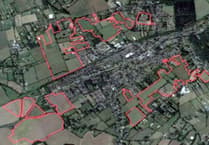MEDSTEAD and Four Marks residents are reaching the end of their tether as long-awaited ‘improvements’ to the road system across the railway bridge at the A31 junction with Boyneswood Road fail to address growing safety concerns.
Many believe it is only a matter of time before someone is seriously injured while crossing the bridge which, they argue, is not strong enough to cope with the increased volume of traffic generated by burgeoning development.
Being the sole means of access at this point both for vehicles and pedestrians, the call is for the urgent installation of a separate pedestrian footbridge.
As the owner of the bridge, the Mid Hants Railway is also concerned.
Chairman and managing director Colin Chambers said: “Mid Hants Railway too has concerns over safety on Boyneswood bridge and has engaged Tony Gee and Partners, consultant bridge engineers, to negotiate on the company’s behalf with Hampshire County Council and the developers.”
Carried out by The William Lacey Group, with the approval of Hampshire Highways, as a condition of planning attached to the building of 80 more homes on the Friars Oak farm site on Boyneswood Road, and designed to mitigate the impact of increased vehicle movement on the road system, the ‘improvements’ have included the introduction of a one-way priority system and the narrowing of the carriageway across the Victorian bridge to facilitate a ‘virtual’ footpath.
While the original plan was for the footpath to be delineated by a line painted on the road, this was viewed as “totally inadequate” and councillors fought to secure the installation of a line of raised paving stones. But already these are being pushed out of line as large vehicles struggle to keep within the limits of the restricted carriageway.
After five years of rising public concern over the unsuitability of the bridge to deal with increasing traffic volume and to accommodate safe use by pedestrians, cyclists and horse riders, residents have had enough.
In describing the improvements as “little short of underwhelming” in a letter to the Herald this week, Boyneswood Road campaigner David Curtis wrote: “The planning approvals for two large housing estates adjacent to each other in this area of inadequate infrastructure has highlighted the ignorance that East Hampshire District Council (EHDC) and Hampshire Highways have in their appreciation of local issues.
“The William Lacey Group, responsible for the Friars Oak farm application so heavily opposed by hundreds of locals, proposed the improvement and received enthusiastic endorsement from Hampshire County Council Highways. Lacey’s task was to facilitate the increased traffic generated by an 80-house estate on an already busy junction with the A31, while ensuring pedestrian safety. Their solution achieves neither. It’s a botched job done at minimal cost, and indifferent to the risk to public safety.
“How does narrowing the road increase traffic capacity and how will a glued-on brick stop a 10-ton truck – or even a small car for that matter? The flaws in the logic are obvious.”
Trinity Hill resident John Stubbington was equally scathing. saying: “If this is what the county highway authority and the district council find satisfactory, then we must all pray for the safety of road users and pedestrians on that bridge. Clearly the aggregate volume of traffic will do nothing but increase as the new developments actually start.”
But the problem appears wider. David Lewis has concern also for the amount of additional traffic that is now funnelled from the bridge and along the length of Boyneswood Road and Red Hill.
He said: “There have been at least two major accidents on this half-mile stretch of road in the last year, both occurring at the opposite end of the road to the bridge. Residents have not seen any mention from Hampshire County Council of any plans to enhance safety for pedestrians, cyclists and horse riders further along the road or plans to slow down speeding traffic.”
Mr Lewis highlights the e-mail correspondence received from the county council last year which states: “The current injury accident record does not warrant intervention by the safety engineering team at present. Engineering measures are usually considered when four or more accidents have occurred at a single location, or when three accidents with similar features have occurred in a five-year period.”
In urging the county council to take a more “holistic view” of the
impact of increased traffic volume on the whole of the road, Mr Lewis is dismayed that residents are being forced to wait until more accidents occur before any action can be taken.
Echoing safety fears, Friars Oak resident Fabio Perselli added: “With such a shoddy and unsightly solution, no attempt appears to have been made to preserve any of the character of this attractive Victorian railway bridge.”
District councillor Ingrid Thomas and county councillor Mark Kemp-Gee have been working tirelessly to try to address the problem.
Mrs Thomas is adamant, saying: “Boyneswood Road bridge should, in my opinion, have a separate pedestrian bridge. I do not believe that it is safe to mix an increased number of cars and lorries with an increased number of pedestrians, cyclists and horse riders. A separate bridge would not only allow safe crossing for vulnerable pedestrians but also mean that the road could be two way instead of pinch pointed.”
Their work resulted in a study being undertaken which has shown that “the junction of Boyneswood Road and the A31 will be over capacity in the near future”. As a result, several options have been suggested which are being investigated and the pair are hoping to work with Mid Hants Railway to develop a safer bridge crossing.
The William Lacey Group was unavaiable for comment when the Herald went to press.





Comments
This article has no comments yet. Be the first to leave a comment.